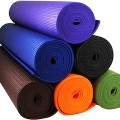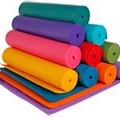Yoga Mat Reviews; How to Choose a Yoga Mat – Part 3 of 3.
MATERIAL
Most standard yoga mats are made of PVC or vinyl. Newer, more earth-friendly options include natural and recycled rubber, jute, and organic cotton or natural cotton (which means the fabric is not treated with synthetic finishes during manufacturing). Most yoga mats are chemically treated unless they are organic or have strict eco-friendliness materials.
If you’re allergic to latex, avoid yoga mats made of natural rubber. If you want to stick with sticky, choose a yoga mat made out of PVC, which can endure your sun salutations for more than a decade. A sticky mat keeps you from sliding all over the place and helps you maintain your alignment as you move from one pose to another, as well as when you hold poses for several seconds like Warrior Pose. PVC yoga mats have the highest sticky factor. I recommend washing a mat with soap and letting it air dry if it is treated with chemicals.
ECO-FRIENDLINESS
Yoga mats
As yogis, we hold ahimsa, or non-violence dear to us. That makes practicing on a yoga mat that will ultimately end up clogging a landfill for decades to come bothersome.
Earth-friendly yoga mats are typically made from natural or recycled rubber. These mats may also include natural materials, such as jute or organic cotton.
Wait a minute….what the F–K is jute? I’ve been practicing yoga for over 15 years and never heard the word jute before I did some research into how to choose a yoga mat. Jute is a natural plant fiber grown primarily in South East Asia. Jute is a highly versatile fiber, combining breathability with high tensile strength.Jute plants take only 4-5 months to grow to maturity, making them a sustainable resource. They clean the air by consuming carbon dioxide, and the leaves are a natural soil conditioner. Jute mesh has the strength of fiberglass and the biodegradability of lawn clippings. However, the natural fibers of the mat can be very itchy and uncomfortable until you wear it in a little. No funky rubbery smell because its a mixture of natural fibers, which also makes it super easy to keep your grip; your hands rarely slip no matter how much you sweat. Be careful because bits of the material can start to come off with wear if you use this with high frequency.
If eco-friendliness is important to you, avoid mats made of PVC, which does not break down in landfills and is difficult and costly to recycle. Rubber and cotton mats, while available in a range of thicknesses, tend to be thicker and slicker than PVC mats. You can get a mat that’s eco-friendly, has a thickness that meets your needs for comfort and portability, and has a texture that prevents slippage.
YOGA MAT CUSTOMIZATION
A recent celeb trend, one in which Jennifer Aniston gave to Oprah recently, was a custom yoga mat of Oprah’s dogs from yogamatic.com is to have a design you choose on the mat. If you have a friend or family members that does yoga on a regular basis this is an outstanding present. Before you buy this, find out how much they like or don’t like the current mat they use. Find out if it works for them for thickness, portability and the materials. A yoga teacher friend of mine is getting married and doesn’t want all the traditional china dishes so we ‘re going to put her wedding photo on her mat…. so excited about her reaction!
PRICE RANGE
Typically, a basic 1/8 inch thick, plain solid-color PVC sticky mat will be toward the low end of the price range. From there you may pay more for patterns, designs or logos; premium thickness; antimicrobial treatments; and cool textures, especially raised tactile patterns. Eco-friendly mats tend to be toward the high end of the price range. While you can get mats at most places that sell anything sporty at most major retailers like Walmart or Target, or specialty stores focused on yoga and pilates gear like Amazon and Yoga Accessories with a much wider variety of products.

